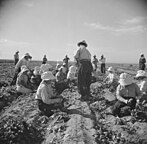| Part of the history of Asian Americans and United States home front during World War II | |
Clockwise from top left:
| |
| Date | February 19, 1942 – March 20, 1946 |
|---|---|
| Location | Western United States[1] |
| Cause | Executive Order 9066 signed by Franklin D. Roosevelt |
| Motive |
|
| Perpetrator | United States federal government |
| Outcome |
|
| Deaths | At least 1,862;[4] at least 7 homicides by sentries[5] |
| Inquiries | Commission on Wartime Relocation and Internment of Civilians (1983) |
| Prisoners | 120,000 Japanese Americans, mostly living on the West Coast |
| Supreme Court cases |
|
| Part of a series on |
| Discrimination |
|---|
 |
During World War II, the United States forcibly relocated and incarcerated about 120,000 people of Japanese descent in ten concentration camps operated by the War Relocation Authority (WRA), mostly in the western interior of the country. About two-thirds were U.S. citizens. These actions were initiated by Executive Order 9066, issued by President Franklin D. Roosevelt on February 19, 1942, following the outbreak of war with the Empire of Japan in December 1941. About 127,000 Japanese Americans then lived in the continental U.S., of which about 112,000 lived on the West Coast. About 80,000 were Nisei ('second generation'; American-born Japanese with U.S. citizenship) and Sansei ('third generation', the children of Nisei). The rest were Issei ('first generation') immigrants born in Japan, who were ineligible for citizenship. In Hawaii, where more than 150,000 Japanese Americans comprised more than one-third of the territory's population, only 1,200 to 1,800 were incarcerated.
Internment was intended to mitigate a security risk which Japanese Americans were believed to pose. The scale of the incarceration in proportion to the size of the Japanese American population far surpassed similar measures undertaken against German and Italian Americans who numbered in the millions and of whom some thousands were interned, most of these non-citizens. Following the executive order, the entire West Coast was designated a military exclusion area, and all Japanese Americans living there were taken to assembly centers before being sent to concentration camps in California, Arizona, Wyoming, Colorado, Utah, and Arkansas. Internees were prohibited from taking more than they could carry into the camps, and many were forced to sell some or all of their property, including their homes and businesses. At the camps, which were surrounded by barbed wire fences and patrolled by armed guards, internees often lived in overcrowded barracks with minimal furnishing.
In its 1944 decision Korematsu v. United States, the U.S. Supreme Court upheld the constitutionality of the removals under the Due Process Clause of the Fifth Amendment to the United States Constitution. The Court limited its decision to the validity of the exclusion orders, avoiding the issue of the incarceration of U.S. citizens without due process, but ruled on the same day in Ex parte Endo that a loyal citizen could not be detained, which began their release. On December 17, 1944, the exclusion orders were rescinded, and nine of the ten camps were shut down by the end of 1945. Japanese Americans were initially barred from U.S. military service, but by 1943, they were allowed to join, with 20,000 serving during the war. Over 4,000 students were allowed to leave the camps to attend college. Hospitals in the camps recorded 5,981 births and 1,862 deaths during incarceration.
In the 1970s, under mounting pressure from the Japanese American Citizens League (JACL) and redress organizations, President Jimmy Carter appointed the Commission on Wartime Relocation and Internment of Civilians (CWRIC) to investigate whether the internment had been justified. In 1983, the commission's report, Personal Justice Denied, found little evidence of Japanese disloyalty and concluded that internment had been the product of racism. It recommended that the government pay reparations to the detainees. In 1988, President Ronald Reagan signed the Civil Liberties Act of 1988, which officially apologized and authorized a payment of $20,000 (equivalent to $52,000 in 2023) to each former detainee who was still alive when the act was passed. The legislation admitted that the government's actions were based on "race prejudice, war hysteria, and a failure of political leadership." By 1992, the U.S. government eventually disbursed more than $1.6 billion (equivalent to $4.12 billion in 2023) in reparations to 82,219 Japanese Americans who had been incarcerated.
- ^ National Park Service (2012). Wyatt, Barbara (ed.). "Japanese Americans in World War II: National historic landmarks theme study" (PDF). Washington, DC: U.S. Department of the Interior. Archived from the original (PDF) on January 13, 2015. Retrieved February 22, 2017.
- ^ a b Cite error: The named reference
CongressReportwas invoked but never defined (see the help page). - ^ "Executive Order 9066: Resulting in Japanese-American Incarceration (1942)". September 22, 2021.
- ^ Cite error: The named reference
Fisetwas invoked but never defined (see the help page). - ^ Cite error: The named reference
homicideincampwas invoked but never defined (see the help page).





